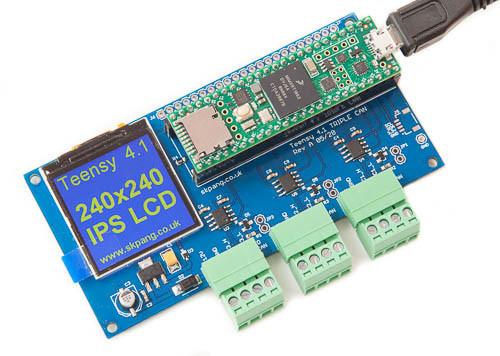Blog
Recent Posts
Developing CAN and CAN FD Applications with the Teensy 4.1 Triple CAN Bus Board and IPS Display
Posted by on
 As embedded systems continue to evolve, the demand for robust, real-time communication interfaces like Controller Area Network (CAN) and CAN FD (Flexible Data-rate) is rapidly increasing across multiple industries. Whether you're building electronic control systems for vehicles, developing automation networks in factories, or integrating sensors and instruments on marine vessels, CAN Bus remains the gold standard for reliable, fault-tolerant communication.
As embedded systems continue to evolve, the demand for robust, real-time communication interfaces like Controller Area Network (CAN) and CAN FD (Flexible Data-rate) is rapidly increasing across multiple industries. Whether you're building electronic control systems for vehicles, developing automation networks in factories, or integrating sensors and instruments on marine vessels, CAN Bus remains the gold standard for reliable, fault-tolerant communication.
For developers, engineers, and hobbyists working at the cutting edge of these technologies, the Teensy 4.1 Triple CAN Bus Development Board with a 240x240 IPS LCD Display offers a powerful and compact solution purpose-built for modern CAN/CAN FD projects.
A Compact Powerhouse: The Heart of the Board
At the core of this platform is the Teensy 4.1 microcontroller, powered by a 600 MHz Arm Cortex-M7 processor — one of the fastest processors available in the microcontroller space. This exceptional processing speed, combined with 1 MB of SRAM, 2 MB of Flash memory, and hardware floating-point support (FPU), ensures that even the most data-intensive tasks and real-time protocols can be handled with ease.
In addition to sheer computational power, the Teensy 4.1 offers features essential for embedded CAN development:
-
Cryptographic acceleration for secure communication.
-
Built-in Real-Time Clock (RTC) for timestamping CAN messages or scheduling events.
-
Wide-ranging I/O compatibility for sensors, storage, and interface expansion.
-
Native Ethernet capability (via additional magjack), enabling hybrid networks of CAN and Ethernet-based communication.
Triple CAN Bus Interface: Two Classical, One CAN FD
The standout feature of this board is its triple CAN Bus interface, offering:
-
Two CAN 2.0B (Classical CAN) interfaces, ideal for existing vehicle and industrial systems.
-
One CAN FD interface, enabling support for high-speed, high-payload messages up to 64 bytes — essential for modern vehicles and sensor arrays.
All three CAN channels are electrically isolated and come with 120 Ohm termination resistors, ensuring signal integrity in noisy environments. This makes the board particularly suitable for real-world deployment in lab testing or field diagnostics.
The combination of Classical CAN and CAN FD provides a development platform that’s compatible with legacy systems while still supporting future-proof technology. Developers can prototype bridge devices, perform protocol conversion, or analyze message traffic across multiple networks simultaneously.
Designed for Development in Automotive, Industrial, and Marine Applications
The Teensy 4.1 Triple CAN board is especially suited for applications in:
Automotive
-
ECU development and simulation for OEMs or aftermarket systems.
-
Diagnostics and telemetry for OBD-II, UDS, or J1939 networks.
-
Testing and bridging CAN to CAN FD systems within EV platforms or advanced ADAS modules.
-
Simulating sensor or actuator traffic for autonomous vehicle research.
Industrial Automation
-
Designing and debugging PLC networks and fieldbus communication.
-
Interfacing CAN-based devices such as sensors, actuators, and motor controllers.
-
Gateway development between Classical CAN and Ethernet, CANopen, or Modbus systems.
Maritime & Marine Electronics
-
Integration with NMEA 2000 for navigation, engine, and environmental monitoring.
-
Custom instrumentation panels or relay controllers using the onboard TFT LCD.
-
CAN FD-based communication for high-speed marine data logging.
Real-Time Feedback with 240x240 IPS LCD Display
Adding a 1.54” 240x240 wide-angle IPS TFT LCD display makes this board more than just a back-end processor — it becomes a user interface platform. This bright, crisp display is ideal for:
-
Real-time CAN traffic monitoring.
-
Displaying sensor readings, error states, or debug messages.
-
Building interactive test tools or GUI-based diagnostics.
Because the display is tightly integrated with the Teensy microcontroller, developers can use libraries like Adafruit GFX, lvgl, or TFT_eSPI to quickly create informative dashboards, graphs, and status panels.
Robust Power and Hardware Design
To make the board field-ready, it includes an onboard voltage regulator accepting input from 7V to 12V DC, which is typical in automotive and industrial power systems. Even more important, reverse voltage protection ensures your development board survives miswiring or unstable test environments — a must-have for garage tinkerers and professional engineers alike.
Software Compatibility: Arduino IDE and Beyond
Despite its high-performance hardware, the Teensy 4.1 remains developer-friendly, thanks to its full compatibility with the Arduino IDE and the Teensyduino extension. Developers can build complex, real-time CAN applications using well-maintained libraries like:
-
FlexCAN_T4 – for comprehensive CAN 2.0B and CAN FD support.
-
Metro, TimerOne, Bounce2 – for scheduling, timing, and interface control.
-
LittleFS or SD – for logging CAN data to local storage.
For advanced users, PlatformIO and native C/C++ toolchains offer even more control and integration with professional workflows.
Conclusion: A Versatile Tool for the Future of CAN Networks
As vehicle and industrial systems continue to evolve toward increased data throughput, modular design, and real-time responsiveness, developers need tools that can grow with the technology. The Teensy 4.1 Triple CAN Bus Board is that tool — offering both the legacy compatibility of Classical CAN and the performance boost of CAN FD in a single, compact package.
With its powerful processor, versatile I/O, integrated LCD, and triple CAN support, this board is ideal for engineers looking to prototype, test, and deploy applications in the most demanding environments — from smart vehicles to smart factories and the open ocean.
If you're ready to explore the next generation of CAN-based development, this board is the perfect place to start. More information...
 Loading... Please wait...
Loading... Please wait...
